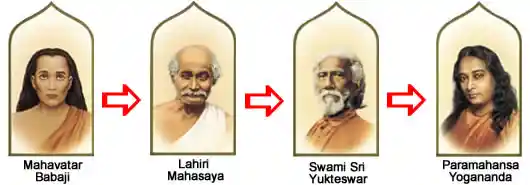Gurus of Kriya Yoga Part 2 — Encapsulating Yogic Traditions
Kri is the work that man does and the soul, Ya in ‘Kriya’, is pulled by God through the strings of breath. In part 2 we will look at the four Gurus who spread the word of Kriya Yoga to the world.

The Gurus of Kriya Yoga. Transmission of Kriya Yoga from master to master. Source: yogananda.com.au
Kriya Yoga, a forgotten scientific meditation practice, was rediscovered and revived by Mahavatar Babaji. It became his life's purpose to find the right disciples to carry this system forward into the world so that it might be utilized to unite mankind and help them realize their common goals. Kriya Yoga, the method of God-realization, would eventually spread over all regions, aiding in the harmonization of nations via man's own, transcendental awareness of the Infinite Father, Babaji reportedly prophesied.
Babaji was born and lived a long time ago, but there are no records of his birth or death. For generations, the deathless avatar has lived in the remote Himalayan regions and only revealed himself to a few blessed people.
He taught the method to Lahiri Mahasaya; "The Kriya Yoga that I am giving to the world through you in this nineteenth century is a revival of the same science that Krishna gave to Arjuna millennia ago; and that was later known to Patanjali and Christ, and to St. John, St. Paul, and other disciples," Babaji said when he initiated Lahiri Mahasaya.
Mahavatar Babaji taught him the science of Kriya Yoga and told him to give the sacred technique to sincere disciples. Lahiri Mahasaya went back to his home in Banaras to complete this task. As the first person to teach the lost ancient Kriya science in modern times, he is known as a key figure in the revival of yoga in modern India because of his careful, accepting, and affectionate way of teaching. Lahiri is known as a Yogavatar, or "Incarnation of Yoga" because he was chosen by yogic masters to teach the world about the quintessence of yoga.
One of Mahasaya’s disciples, Sri Yukteswar, thought that combining the spiritual traditions of the East with the science and technology of the West could help people who were suffering in mental, and spiritual ways. When the Swami met the materialized Mahavatar Babaji at the Kumbh Mela of 1894 in Allahabad, these ideas were crystallized for him when Babaji had asked him to write a book comparing Hindu scriptures and the Christian bible.
Sri Yukteswar is said to have a gentle voice, pleasant presence, and a high moral character and holiness. He is known as a Jnanavatar, or "Incarnation of Wisdom”. His honest and penetrating insight, stern nature, and strict discipline training methods helped to prepare his disciple, Yogananda, to start his global mission in the West. Paramahansa Yogananda was declared the sole successor to Sri Yukteswar's properties and ashram.
Mahavatar Babaji appeared in Paramahansa Yogananda's meditation just before he went to America in 1920 when he sat earnestly asking for divine reassurance about the mission he was going to undertake. Babaji addressed him as follows: “Follow the behest of your guru and go to America. Fear not; you shall be protected. You are the one I have chosen to spread the message of Kriya Yoga in the West.”
Before Parmahansa Yogananda arrived in America in 1920, Mahavatar Babaji informed him that he had been selected for this holy mission: "You are the one I have chosen to transmit the message of Kriya Yoga in the Western world," Yogananda recounts in his book, 'Autobiography of a Yogi.' I met your teacher Sri Yukteswar at a Kumbha Mela a long time ago, and I informed him then that I would send you to him to get instruction.”
Yogananda's work in America contributed to the widespread acceptance of Kriya Yoga throughout the world. He established the Yogoda Satsanga Society of India, which operates under the auspices of the Self-Realization Fellowship and provides lessons on the scientific method, and initiates practitioners into the Kriya system in over 54 countries, with over 200 centers in India alone.

Yogananda with his guru, Swami Sri Yukteswar. Image source: Wikimedia Commons

Yogoda Satsanga Ashram, Dakshineswar. One of the YSS headquarters. Source: yssofindia.org


